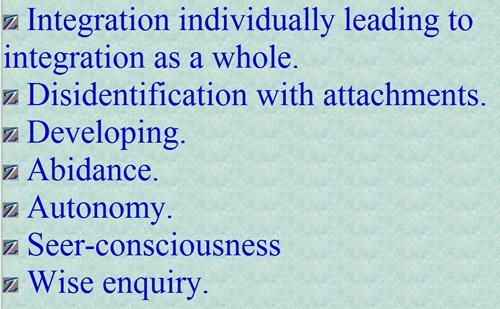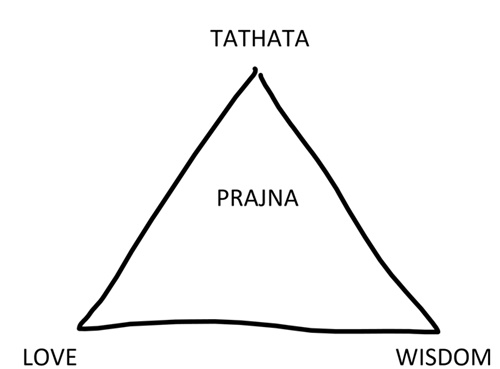|
On the path you are the autonomy that arises from your practice - your meditation.
For zandtaomed bhavana – developing – has always been part of meditation, but with autonomy this bhavana has changed meditation significantly to the extent that zandtaomed does not use the term MwB for his practice any more. This is out of deference not to Buddhadasa's teachings but to the people of Buddhadasa’s tradition who might disagree (see discussion below).
Practice is central to the path, without practice there is limited awakening and maybe no embodiment; without the embodiment of wisdom and love there can only be limited tathata – feeling, knowing and seeing the way things are.
Zandtaomed wants to examine his meditation history to give context. At 23 there was upheaval. During the upheaval there was a bliss time where jhanas led to writing, but these jhanas were not part of a practice so embodiment of that awakening was erratic. With walking there was a centring in nature, with writing there was the occasional touching the Muse but embodiment was all erratic.
Following bill’s conversion to Buddhism towards the end of his teaching life and then early retirement, his dedication to the path increased; this coincided with a developing meditation. This advice is primarily concerned with meditation but his writing practice is integral to his overall practice and that started with retirement.
With his Buddhist conversion meditation became regular. With his Harnham monastery connection that meditation became insight meditation, but after retirement that vipassana developed into Buddhadasa's MwB; that 4 foundations infrastructure remains now in zandtaomed’s autonomous practice. Throughout his MwB practice there was always bhavana – development, but until autonomy the changes made to MwB practice were significant to zandtao yet differing minimally from Buddhadasa's MwB. Now his autonomous meditation still has the 4 tetrad infrastructure but within those tetrads the stages have changed more than minimally. Because zandtaomed is unable to verify that these changes would be acceptable to Buddhadasa as practice (as he is dead), zandtaomed has to stop calling his practice MwB and now calls it autonomous meditation. When it is combined with the Companion, the Seeker Story, and his writing this is now what he calls practice.
The big recent change to zandtaomed’s practice is love and love-wisdom embodiment; love and compassion were key to Buddhadasa’s writings but not part of his book's daily MwB practice. This change is symbolised for zandtaomed by his recognition that love is a Dhamma comrade - a Dhamma comrade arising from meditation, and that he now describes 5 Dhamma comrades – mindfulness/sati, wisdom/sanna, love/karuna, samadhi/concentration and sampajanna/embodiment.
Bringing love and love-wisdom embodiment into daily practice was not a minor change, and whilst zandtaomed does not see any conflict with Buddhadasa he cannot verify this so he has changed to using the term autonomous practice.
In terms of Buddhadasa’s MwB, zandtaomed changed step 15 to include love-wisdom embodiment leading to step 16 as faith in the path leading to love/wisdom and tathata – feeling knowing and seeing the way things are. Love necessitated a change in the 2nd foundation of vedana. Buddhadasa saw the 2nd tetrad as mastering the vedana leading to calm, zandtaomed now sees the 2nd tetrad as releasing attachment to new vedana and old vedana before calming all vedana as stage 7, finally feeling love arising as stage 8 – Buddhadasa does not specifically have feeling love in his MwB practice.
Zandtaomed uses the chakras to develop love and love-wisdom embodiment. Zandtaomed uses these chakras as points on the tai-chi ridgepole – a pole that is a core centre of the individual. Whilst he uses a chakra colour code these colours are not particularly important nor are the chakra vortices themselves; these are are just visualisations for zandtaomed meditation. In his MwB Buddhadasa does not mention chakras.
Finally zandtaomed introduced internal chi gung as kaya conditioner. To begin with this chi gung was to balance weakness in his own body but he now sees it as a good practice for all – releasing tensions that arise in daily life or otherwise, balancing chi in the body and then completely conditioning the body with the breath; throughout the 1st tetrad and his kaya conditioner, Buddhadasa only looked at the breath.
To zandtaomed all these changes are in line with Buddhadasa’s teachings but have strayed so far from what Buddhadasa wrote in Anapanasati Bhavana that zandtaomed has decided to change the name to zandtaomed autonomous practice - zap. When combined with the advice in the Companion, doing the Seeker Story and writing to help embodiment, this is zandtaomed’s full practice.
For zandtaomed autonomy is a signal that an elder giving “zandtaomed advice” or otherwise has formally finished their meditation tuition even though they remain kalyana mitta. With autonomy the seeker begins to establish their own practice. For zandtaomed crossing the threshold of autonomy the Diamond Sutra was of great importance – to remember that practice got you to the threshold, and that practice needs to continue wherever autonomy takes you. The practice that zandtaomed followed came from "Mindfulness with Breathing" by Buddhadasa Bhikkhu (Anapanasati Bhavana). But once over the threshold zandtaomed has amended Buddhadasa's practice to 5 Dhamma comrades including love. Zandtao thinks his amendments are in line with Buddhadasa’s teachings but zandtaomed chooses to emphasise internal chi gung, love and love-wisdom embodiment in his daily practice; these 3 are not explicit in MwB so he has changed the name to zandtaomed autonomous practice – zap (such a trivial acronym for such an important practice).
To develop his practice, bill went to Buddhism, zandtaomed went to Buddhadasa to develop the MwB practice. Now zandtao has crossed the threshold of autonomy, it is autonomy that now develops zandtao and his practice. For zandtao it is religion, religious teachers and meditation teachers or elders who help seekers develop practices. As far as zandtao understands all practices can lead to autonomy (if the seeker keeps aware of the 7 core components of secular practice), and once there is autonomy the seeker chooses their path and what to do next. If a seeker simply follows a teaching, where does the autonomy develop? It might happen as a consequence of teaching but constant wise enquiry helps build the autonomy the seeker needs to follow their paths.
For zandtaomed it is core to his advice as an elder that the seeker develops autonomy on the path; without autonomy can there be awakening and therefore embodiment? As the seeker develops their practice through advice and then autonomy, the seeker becomes their meditation - their practice. As part of the path the use of wise enquiry is an ongoing essential as the seeker develops that autonomy and then changes their practice. Seeker, be your meditation.
Finally zandtao came up with these 7 core components for a secular practice - developed here, and as an elder zandtaomed recommends these core components be part of your practice:-

How do these core components fit in with zandtaomed's autonomous practice?
Not surprisingly they work well with his practice (as he came up with them) especially concerning what they highlight.
What is his practice?
 Meditation Meditation
 Seeker Story Seeker Story
 Writing and z-quest Writing and z-quest
The purpose of zandtaomed advice is now consolidated as helping the seeker find autonomy on the path so for zandtao’s quest into the unknown autonomy(4) is covered. Through zap there arises autonomy(4) and the 5 Dhamma comrades of mindfulness/sati, love/karuna, wisdom/panna, concentration/samadhi and embodiment/sampajanna. Love and wisdom lead to tathata, giving us the seer-consciousness(6) of “feeling, knowing and seeing the way things are”:-

Zandtaomed advice is to work on the Seeker Story, and this is disidentification(2) with upbringing and ongoing disidentification(2) of the conditioning that forms ego. Zap itself is concerned with conditioning of the 1st 3 tetrads continuing the process of disidentification(2) of ego through conditioning.
Zap is concerned with the 3 integrations(1). Overall is the integration of the 4 foundations(1a) – reconnecting with Dhamma integrating kaya (body), vedana (emotions) and citta (sanna-sankhara). In stage 15 of the 4th tetrad there is the integration of love-wisdom(1b) and integrating love-wisdom with interbeing(1c).
In stage 16 is the process of “feeling knowing and seeing the way things are” through faith, this is meditation leading to seer-consciousness(6); there is a conscious process of love, wisdom and tathata – not just the arising process of the 5 Dhamma comrades. Such consciousness(6) also comes through writing. Often through meditation there will arise insight which writing then puts meat on the bones. In writing and sometimes in meditation that happens alongside zap, insight arises from wise enquiry(7) leading to development or bhavana(3). Bhavana through wise enquiry needs to constantly evaluate zap as well as the possibility of improving the Seeker Story.
What is highlighted in zandtao’s practice is the lack of abidance(4). Whilst zap leads to abidance, this does not mean there is abidance 24/7(4). Zandtao knows this weakness – warts’n’all, chooses this weakness, but advises mindfulness including mindful moments to be constantly aware of the need for abidance knowing it does not happen for himself. The core components for zandtao highlight the need for wise enquiry(7) to develop(3) increased abidance (4)!!!!!
Increased abidance.
|


 Zandtao Meditation page
Zandtao Meditation page
 Advice from Zandtaomed
Advice from Zandtaomed

